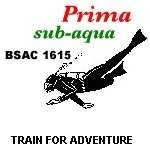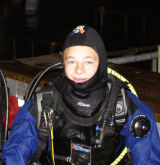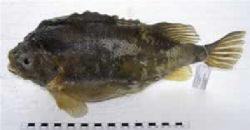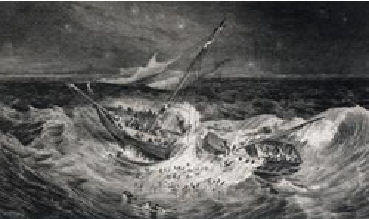
Issue 13 February 2008
Off-Gassing...
(Web Version)
Welcome to the February edition of our newsletter.
Profile of an ocean diver (Ashley Munday)
Items for Sale:
10 litre Cylinder. In test
£50 contact: Richard Mace
0121 232 6007
-------------
Poseidon Cyclone regulator & Octopus (requires service) £50.
Also Poseidon Cyclone regulator & long hose (requires service) £50. see John Searle 07776 411406
--------------
If you have any items for sale please let us know.

(My best buddy, the bad Tamal)
Why did I take up diving? What ever my mum did, I had to do better. Really though, curiosity about the life under there - what was all the fuss about? Was it really any different to a fish tank, apart from the depth?
First impressions – my god its cold! 6 degrees in a semi-dry in Scotland – not the best intro, but great to look down at the 90 metre wall at the Kyle of Lochalsh and think one day I’ll be travelling down there.
My favourite diving so far is the Rhondo – my buddy Lin took me on the deepest dive so far, looking at dead mans fingers.
Had a shock when Mad Lin picked up this huge crab and tried to give it to me - I gave her the bag as well as the crab and thought “I don’t think so!”
Mind you, we ate well that night!
A year later, I got a dry suit, the boat sank, and I got lost with George, Vicky and Kat - lucky for George we didn’t we get a brass ass for that one!
Animal of the Month - Lumpfish
If anybody has any ideas about what they would like to see in the newsletter, please talk to us – or email if you prefer – just remember it’s read by the family!
Editors Corner
Thank you to everyone who has contributed to this months issue, and apologies for any mistakes.
Any further articles for next months edition would be appreciated, (any gossip, scandals, etc that’s printable) so let us know by 24th February.
Hope you enjoyed this issue.
 Atlantic; it is not rare on the British coasts, but becomes more
common farther north. It is so sluggish in its habits that individuals
have been caught with sea-weed growing on their backs. In the spring the
fish approaches the shores to spawn, clearing out a hollow on a stony
bottom in which it deposits an immense quantity of
pink-coloured ova. Fishermen assert that the male watches the spawn
until the young are hatched, a statement which receives
confirmation from the fact that the allied gobies, or at least some
of them, take similar care of their progeny. The
vernacular name, "cock and
hen
paddle," given to the lumpfish on some parts of the coast, is
probably expressive of the difference between the two sexes in their
outward appearance, the male being only half or one-third the size of
the female, and assuming during the spawning season a bright blue
coloration, with red on the lower parts. This fish is generally not
esteemed as food, but Franz
Faber (Fische Islands, p. 53) states that the Icelanders
consider the flesh of the male as a delicacy.' The bones are so soft,
and contain so little inorganic matter, that the old ichthyologists
placed the lump-sucker among the cartilaginous fishes.
Atlantic; it is not rare on the British coasts, but becomes more
common farther north. It is so sluggish in its habits that individuals
have been caught with sea-weed growing on their backs. In the spring the
fish approaches the shores to spawn, clearing out a hollow on a stony
bottom in which it deposits an immense quantity of
pink-coloured ova. Fishermen assert that the male watches the spawn
until the young are hatched, a statement which receives
confirmation from the fact that the allied gobies, or at least some
of them, take similar care of their progeny. The
vernacular name, "cock and
hen
paddle," given to the lumpfish on some parts of the coast, is
probably expressive of the difference between the two sexes in their
outward appearance, the male being only half or one-third the size of
the female, and assuming during the spawning season a bright blue
coloration, with red on the lower parts. This fish is generally not
esteemed as food, but Franz
Faber (Fische Islands, p. 53) states that the Icelanders
consider the flesh of the male as a delicacy.' The bones are so soft,
and contain so little inorganic matter, that the old ichthyologists
placed the lump-sucker among the cartilaginous fishes.
Latin:
Cyclopterus lumpus
Language:
English
Better known as:
lumpfish
Also known as:
cock paddle, sea owl
Shipwrecks of North Wales, part 3.

Throughout the latter half of the 1800s, the Board of Trade kept records of UK ship losses. Steamer ships became common. By 1822, the Albion paddle steamer maintained a regular service between Liverpool and Bangor in the Menai Straits. The Albion wrecked near Rhyl in 1846. In 1831, the Menai Straits was the scene of a disaster - The Rothsay Castle
The Rothsay Castle was a paddle
steamer which was wrecked on the Traeth Lafan (Lavan Sands) at the
eastern end of the Menai Straits, north Wales, in 1831, with the loss of
130 lives.
The Rothsay Castle was built in 1816 for service on the River Clyde,
Scotland, and was later transferred to Liverpool, England, where she was
used for trips along the coast of North Wales. At around mid day on
August 17, 1831, she left Liverpool carrying 150 passengers. She had
been intended to leave at 10 a.m. but was delayed by the weather and the
late arrival of a passenger.
On leaving the Mersey estuary, she encountered a strong NNW wind and a
rough sea. One of the passengers went to see the captain, Captain
Atkinson, to ask him to return to port, but he found Atkinson drunk and
unwilling to consider turning back. By 10 p.m. the ship had still only
reached the Great Orme and the ship was found to have two feet of water
in the stokehold. The pumps were found not to work, there was not even a
bucket available for bailing, and the single lifeboat had a hole in the
bottom and had no oars. At around 1 a.m. on August 18 the Rothsay Castle
ran aground on Dutchman's Bank and after a while broke up, the captain
and the two mates being swept to their death when the funnel collapsed.
A total of 23 passengers were rescued in the morning.
Bodies were washed up over a wide area of Anglesey and the mainland. An
inquest was held at Beaumaris and the jury concluded:
had the Rothsay Castle been a seaworthy vessel and properly manned, this
awful calamity might have been averted. They therefore cannot disguise
their indignation at the conduct of those who could place such a vessel
on this station ....
As a result of this disaster, a lifeboat was established at Penmon on
the SE tip of Anglesey in 1832 and a lighthouse built there in 1837.
Typical! The girls couldn't find a wreck this month, so
Did you know........
· Whales can’t swim backwards.
· An octopus has three hearts.
· An average British family uses 2 miles of toilet paper a year.
· On average, we all contain 2 molecules of Julius Caesar’s last breath.
· A snail can have about 25,000 teeth.
· Sailors used to wear a gold earring so that they could always afford a proper burial when they died.
· For Wendy's interest — each time you crack a whip, the end of it has to travel at speed of sound.
· Blonde beards grow faster than dark ones - we’ll be looking! Could this be the next competition?
· Dolphins sleep with one eye open ...useful on Prima trips.
· Every pint of water taken from the Red Sea contains 4 ounces of salt.